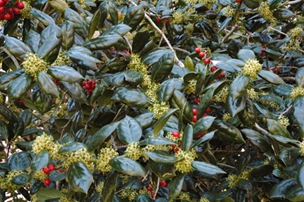Holly categories: Traditional, deciduous, inconspicuous

We've known people who love the winter color of fruit so much that they net their hollies or engage in scare tactics to keep birds from feeding there. Then, berries may last right into the next blooming season before rotting and dropping off.
We love traditional, evergreen, spiny leaf, berry-bearing
hollies
There are two other two holly groups:
- Deciduous, red berried hollies such as Michigan
holly/winterberry (I. verticillata), Japanese winterberry
(I. serrata) and possumhaw (I. decidua), or
- The many species that are often mistaken for "some kind of
boxwood." Inkberry (I. glabra), Japanese box-leaf holly
(I. crenata) and yaupon (I. vomitoria) are
leaders in this group. (Clue to differentiating holly and boxwood:
Holly species have alternate arrangement of leaves. Boxwood leaf
arrangement is opposite)

Right: English holly, native across the UK and Europe, can't
usually handle
winters colder than zone 7, nor can it thrive in hot, dry
summers.
It's distinctive for curved, forward pointing spines and, in many
varieties,
young twigs that are purple.
Below: These box-leaf evergreen hollies with black berries
and spineless foliage await later discussion. Note the alternate
leaf pattern, a mark of the holly (Ilex) species. If it
was a boxwood species, each leaf would have a partner directly
opposite it on the stem.

